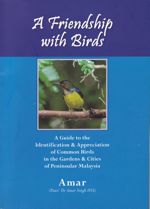For the past many months the blog has been posting one observation after another by Dato’ Dr Amar-Singh HSS, so much so that he is uncomfortable with hogging the limelight. Only when assured that his many observations need to be shared that he feels comfortable with his many postings. After all, observations not recorded and shared, cannot be taken as contributing to the advancement of our ornithological knowledge.
Amar, as he prefers to be addressed, resides in Ipoh, in the Malaysian state of Perak. His birding playground is the wild growth area of Keledang-Sayong, Tambun interior and Ulu Kinta Reserve around his hometown. He usually wanders around these areas alone during weekends, not simply looking at birds, but studying their habits at the same time. He carries a camera to document his observations, refusing to use flash in his photography as he strongly believes that this will cause his subjects distress. Currently he is also armed with a recorder, to record calls and songs. His weekend ‘spiritual’ outings prepare him for a hectic and demanding week ahead at the Ipoh General Hospital where he is Consultant Community Pediatrician and Head of the Pediatric Department.
I made contact with Amar in May 2009 when he enquired as to how he could contribute to the blog. And soon he sent in his first contribution, on the Raffles Malkoha (Phaenicophaeus chlorophaeus). Since then his contributions have not stopped coming. And to date he has more than 100 contributions to his name, with 77 already posted and the rest on the waiting list.
Most birdwatchers return from trips with lists of species seen. Not Amar. He returns from each trip with one or more accounts of his encounters with his feathered friends… and always accompanied with images. He studies his birds regardless of whether they are rarities or ‘trash birds’ – a term birdwatchers use to refer to the common everyday species. I am always amazed at his uncanny ability to see through the plumage and bring back interesting bahavioural accounts.
Now what makes Amar tick? Apparently G. C. Madoc’s classic “An introduction to Malayan birds”. Written when the author was a prisoner-of-war at Singapore’s Changi prison during the Japanese occupation, the book has left a lasting impression on Amar. A birdwatcher for 35 years, Amar has successfully jettison the ‘listing’ habit that many birdwatchers are unable to shrug off. He admits to being a ‘twitcher’ once, although he prefers the label ‘ticker’ i.e. one who ticks off a checklist of birds as soon as a new species is sighted. But after ticking off his first 200 species within a rather short time, he found twitching very unfulfilling. So he moved off to getting to know more about his subjects.
Amar is a regular contributor to the database of the Oriental Bird Club, the Oriental Bird Images, since February 2006. So far, he has lodged more than a thousand images in this database.
Amar lives with wife Datin Dr Swee-Im Lim in Ipoh where they have a home with a small garden overgrown with mature trees and shrubs. He goes out of his way to encourage tropical mistletoes [1, 2, 3, 4 & 5] to grow on his plants, as these semi-parasitic plants attract sunbirds, flowerpeckes and more. So far, his garden has been visited by about 48 species of birds, of which 35 are frequent visitors.
“A Friendship with Birds: A Guide to the Identification and Appreciation of Common Birds in the Garden and Cities of Peninsular Malaysia” was published by Amar last year (right). It is aimed at newcomers to the birding scene. The book was reviewed in Malaysia’s New Straits Times and can be viewed HERE.
.
.
Image of Dato’ Dr Amar Singh HSS and Datin Dr Swee-Im Lim (top) courtesy of Amar.
YC Wee
Singapore
March 2010
Reference:
Madoc, G. C. (1956). An introduction to Malayan birds. Malayan Nature Society, Kuala Lumpur. (revised ed.) 234 pp.











314 Responses
Thanks for this, an informative post. Having read so many of Amar’s invaluable contributions, it is fascinating to learn about the man behind them. Kudos to him!
Yes, thanks for sharing about Amar. His observations, along with those of other posters, really help encourage me to watch birds more carefully, as well as providing fascinating insights. Hopefully these observations will lead to others confirming them or possibly understanding the behaviors differently – it is a great kind of “citizen science”.
Hopefully Amar would inspire traditional birdwatchers to upgrade and be more productive in the field. I have observed many newly-recruited local birdwatchers stop getting involved in the activity after one or two years of following the flock. After all, how long would it be before you get bored with the usual birds that are around? Wait for the rare species to appear once in a while? But then many newbies are left in the cold as they are not informed of such sightings until the birds have left. Yes, kudos to Amar.
Congratulations Amar Well done!.
Daisy O’Neill